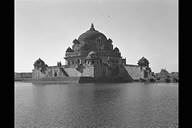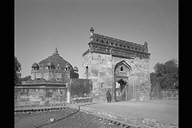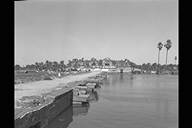
Ѓ@ЃЁDetailed Explanation
Ѓ@ЃЁPaln and List of Photos
SASARAMЃ@
Ѓ@The Sur Dynasty, who came from Afgan tribe, is a branch family of Lodi Dynasty (1451-1526) controlled Delhi in the late 15th century. And it began with the first ruler, Ibrahim Khan Sur, who controlled the Narnaul area. Its second ruler Hasan Khan Sur, the third ruler, Sher Shah Sur (reign 1540-45) and the fourth ruler Salim Khan Sur (reign 1545-1554) constructed unique mausoleums in Sasaram situated in the middle of the Ganga river. The tomb of Hasan Khan Sur is in the town and that of Sher Shah is in the western suburb. That of Salim Shah, which is unfinished, is about 2km northwest of the town.(Naoko Fukami)
Ѓ@
1.SHER SHAH SURЃ@(c.1545)
2.HASAN KHAN SUR (c.1535)
3.SALIM SHAH (Middle of 16th C.incomplete)
 |
Ѓ@Sher Shah (reign
1540-45) of the Sur Dynasty, once expelled the second
Mughalid emperor, Humayun from Delhi. His tomb is in
Sasaram where many tombs of the Sur family are situated.
It is said that "it shows how the tomb of a king
should be", "It is one of the most praiseworthy
tombs among those in India". This tomb built in the
mid 16th century, is constructed in the middle of a
nearly square-shaped artificial lake. The entrance gate
on the north lake side built on a square plan with a dome
has its entrance openings in four directions and there is
a long passage going across the lake. P Brown compares
the environment of the tomb with that of Muhammad Bin
Tugluq which is build outside the fort of Tughluqabad.
And the long passage to the tomb on the lake also seems
to be similar to that of the founder of the Tugluq
Dynasty, which floats on the water in rainy season.
(Matsuo Ara) Ѓ@ЃЁDetailed Explanation Ѓ@ЃЁPaln and List of Photos |
Ѓ@
 |
Ѓ@The father of Sher
Shah Sur, Hasan Khan was the child of Ibrahim Khan, who
was active in Bihar under Baharol Shah Lodi. He increased
his power as an Afghan in Jaunpur under the Sikandar Lodi
reign and was given a land of Sasaram Parganah. He was
killed in the battle of Kalinjar. His tomb surrounded by
walls on four sides was designed by a Panjabi named
Aliwar Khan sometimes before 1550, like other Sur
buildings. It is said that this is one of the early works
of this excellent architect, probably from 1535. In its
structure and style, it has many similarities with tomb
architecture, built in Delhi during the Sayyid and Lodi
Dynasties. P.Brown points out the immaturity of this tomb
in comparison with later buildings in the Sur Dynasty.
(Matsuo Ara) Ѓ@ ЃЁPaln and List of Photos |
Ѓ@
 |
Ѓ@Currently this tomb
is in desolation. However, the concept of this building
was for it to float on the lake, like the tomb of his
father Sher Shar. It is assumed that the tomb, built on a
low basement, was great in size, however, it seems that
the construction was abandoned in mid-course. Currently,
only an arch-shaped entrance and a small part of the
walls remain. I feel this fragile arch may symbolize the
life of the fourth ruler of the Sur Dynasty who lost
supremacy in Delhi and became the protagonist in the
story of the fall of the Afghan power, or is it my
sentiment ? (Matsuo Ara) Ѓ@ Ѓ@ЃЁList of Photos |
Ѓ@
Ѓ@